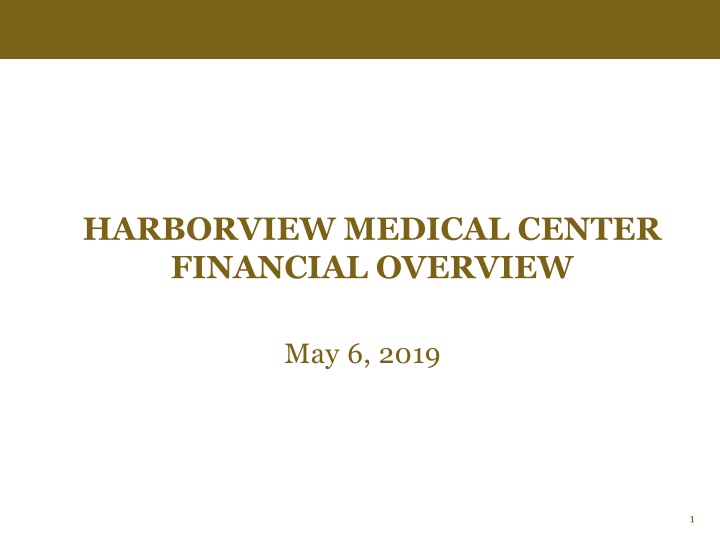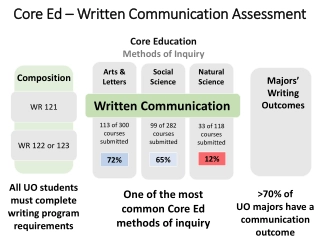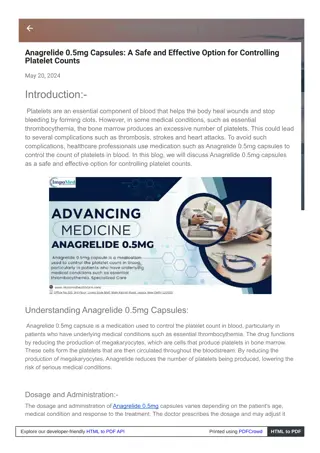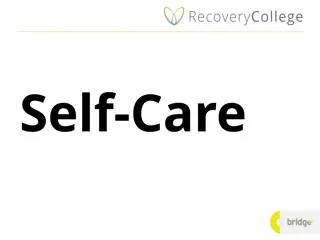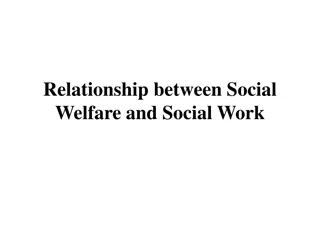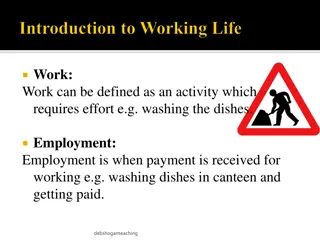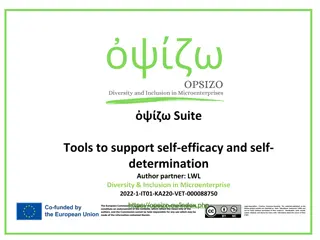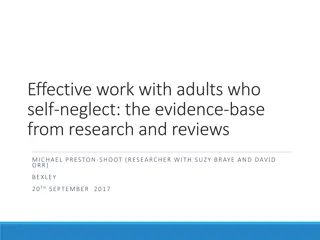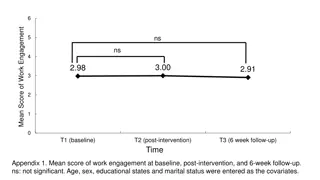Building Financial Self-Efficacy with Social Work Students
This material delves into financial self-efficacy, financial capability, and financial literacy, essential for promoting improved financial well-being in individuals, families, and communities. The definitions and concepts presented aim to empower social work students with the necessary knowledge, skills, and behaviors to make sound financial decisions and translate knowledge into meaningful change, even in challenging circumstances.
Download Presentation

Please find below an Image/Link to download the presentation.
The content on the website is provided AS IS for your information and personal use only. It may not be sold, licensed, or shared on other websites without obtaining consent from the author.If you encounter any issues during the download, it is possible that the publisher has removed the file from their server.
You are allowed to download the files provided on this website for personal or commercial use, subject to the condition that they are used lawfully. All files are the property of their respective owners.
The content on the website is provided AS IS for your information and personal use only. It may not be sold, licensed, or shared on other websites without obtaining consent from the author.
E N D
Presentation Transcript
HARBORVIEW MEDICAL CENTER FY17 OPERATING BUDGET GUIDING PRINCIPLES HARBORVIEW MEDICAL CENTER FINANCIAL OVERVIEW May 6, 2019 1
AGENDA FY20 Budget Guiding Principles Historical Trends & Financial Health FIT Update What are the risks? 2
BUDGET GUIDING PRINCIPLES We will identify, invest and develop systems/services which move us from volume to value, particularly with our mission population. population. We must continue to build growth growth, as able. Investments will be limited to strategic initiatives that support more efficient patient throughput and care management. We will continue transformation of labor productivity to achieve and move Total Expense AWI/CMI Adjusted Discharge benchmarking benchmarking from our current >75 percentile by 2023. We will adopt tools to support daily workforce management provided by Kronos Analytics. Earmarks for planned capital capital replacement, IT Infrastructure prioritization. mission th percentile to the 50 th daily workforce management as 3
FINANCIAL HEALTH - WHAT IS OUR TARGET? in Millions Audited Prelim 2016 Budget 2018 Projected 2021 2017 2019 2020 2022 2023 Total Margin Total Margin % $17.0 1.8% $6.6 0.7% $10.1 1.0% $10.4 1.0% $10.6 1.0% $10.9 1.0% $11.2 1.0% $11.5 1.0% We spend >$3M/day 5
NET REVENUE WHAT IS AT RISK? Through the long range financial planning process, HMC has identified risks to net revenue that exceed $20M/year through FY22. These include: Commercial Significant decreases in OP facility fees and shift to ACN and risk-based plans (up to 50% by FY21) Medicare Payment inflation near zero, decreases for potential risk of IME pooled payments, UCP payments and outpatient facility fees Medicaid Decreases for potential risk in IME pooled payments, Disproportionate Share and outpatient E&M facility fees All Payors Infusion, Supply Markup and Outpatient Radiology An overall assumption of 10% of that risk gets incorporated into the FY20 budget assumptions for net revenue. 6
FINANCIAL IMPROVEMENT AND TRANSFORMATION PROJECT FIT After experiencing negative margins in 2017, UW Medicine embarked on a robust program to improve financial performance and transform how healthcare is delivered. This plan is called financial improvement and transformation, or FIT. Multi-year financial improvement plan Part of our Practice Fiscal Responsibility pillar and long-range financial plan Supports UW Medicine s overall strategic goals Combination of revenue generation, cost-savings and infrastructure Initiatives involve every entity in our entire system Transformation of the way we operate and deliver care Urgent not business as usual Critical to our success and our ability to compete 7
FIT HIGHLIGHTS AND EXAMPLES Revenue Generation Cost Savings Infrastructure Service Growth & Max Cap: Actively hiring OBs & Midwives for CBC growth Physiatrists for SSOH growth Huron is working on how to increase ambulatory access across primary and specialty care through better utilization of existing resources Vizient is working at HMC to alleviate their chronically high patient census Labor Productivity: Vizient & GE are working with us to identify where we are more heavily staffed than comparable organizations We are evaluating a standard vacancy review process for the enterprise Clinical Transformation (EHR) Funding: Standardize technology (electronic health record) CBC Funding: Invest in new amenities for women and infants, specifically at NWH Clinical Products & Purchased Services: Evaluating & quantifying opportunities for reducing pricing and utilization for blood products and orthopedic implants (potentially >$3M in savings) Appropriations: Plan ahead for fluctuations in this funding, specifically at academic medical centers Revenue Cycle*: Reducing write-offs (-0.2% at UWMC) Reducing denials (-7% at HMC) Reducing A/R days (-5.8d at UWMC) Increasing insurance verification secure rates (+22% at HMC outpatient) All while tracking & working to increase staff productivity Non-clinical Products & Purchased Services: Evaluating savings through contract optimization/consolidation (e.g. clinical eng. maintenance, interpreter services, ) Pharmacy Optimization: Implementing an electronic inventory management system to increase JIT ordering and reduce waste (potentially >$2M in savings) Philanthropy: Working on a campaign to support the new childbirth center (CBC) at NWH Group Purchasing Organization (GPO): Potential savings through better group pricing for supplies/equipment ($7.5M FY19 target) * Preliminary metrics 8
RISK MAP The financial plan is a projection based on the best information the organization has today. Risks to achieving the plan are shown below. LRFP RISKS UW MEDICINE HMC Management of Expenses Achievement of Volume Projections enabled by Post-Acute Strategy Medical Center Physical Plant Capacity and Configuration Investment in Information Technology Global Risks Changes in Reimbursement / Net Revenue Erosion Access to Capital Managementof Expenses Current Political Environment Capital Formation Investment in Information Technology Changes in Reimbursement Competitive Environment 9
Questions? 10
